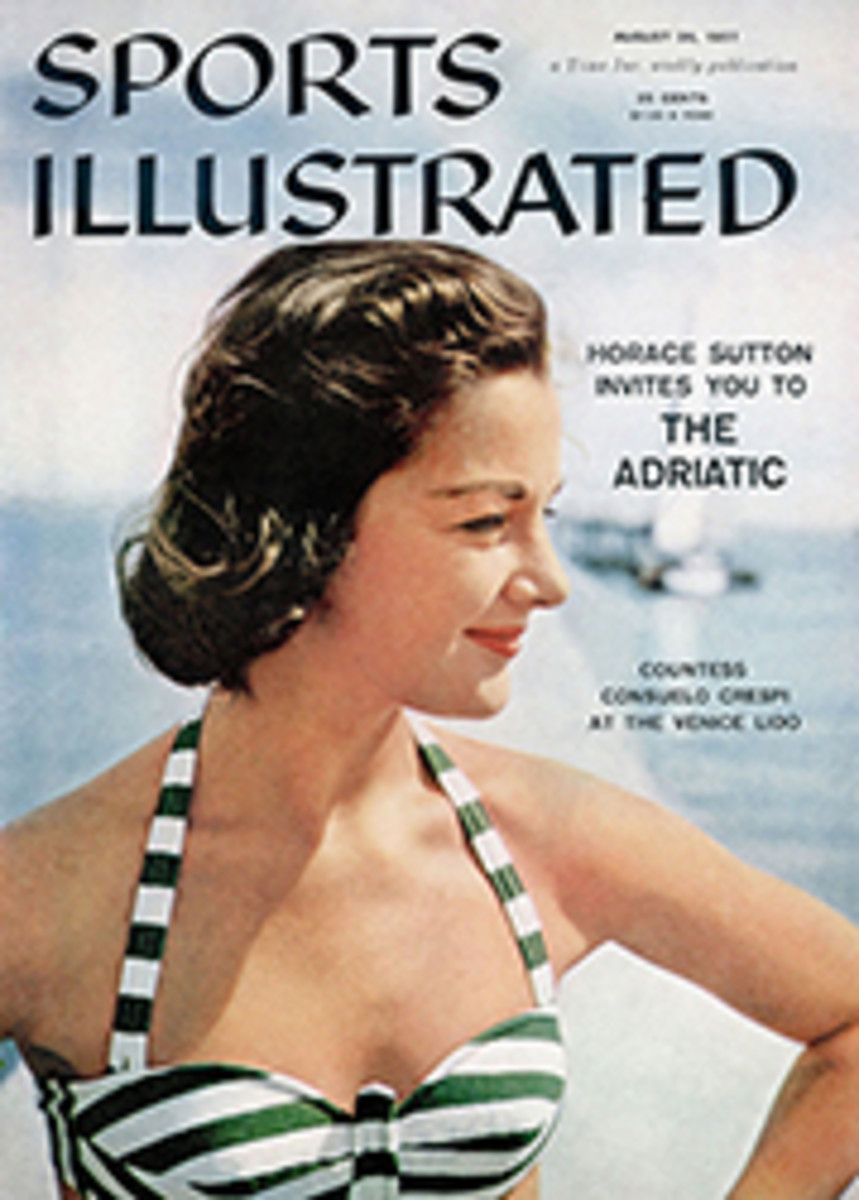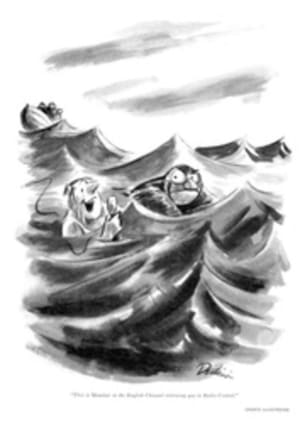
New Faces: THE BRITISH WALKER CUP TEAM
You would think that there would be very little to be said for a competition so one-sided that in 15 matches one team captured no less than 14 of them. This in brief is the history of the Walker Cup, the biennial two-day meeting between the best American and the best British amateurs. What is more, in recent years the matches have seldom been close, the British team failing on each of the last four occasions to win more than three of the possible 12 points (four foursomes on the first day, eight singles on the second). And yet, instead of drooping into a moribund affair, the Walker Cup has remained full of life and interest. How? Well, it is an international match and that always puts a wonderful keenness in the air. Beyond this, as anyone who attends the 16th Walker Cup match next week (August 30, 31) at the Minikahda Club in Minneapolis will experience, the series purveys a wonderful golfing flavor. And beyond this, the British through all their frustrations have never stopped hoping and trying.
Most American fans are fairly well acquainted with Charley Coe, the captain, and the 10 men selected for the 1957 American team: Rex Baxter, Arnold Blum, Joe Campbell, Bill Campbell, Bill Hyndman, Charley Kocsis, Billy Joe Patton, Hillman Robbins, Mason Rudolph and Dr. Frank Taylor. Since very few of the familiar British players are returning, SPORTS ILLUSTRATED has prevailed on Bernard Darwin to introduce the players on whom the long-suffering Britons are pinning the hopes for a revival of their golfing prestige.—H.W.W.
Whatever befalls our British team at Minikahda next week, I think it left our shores generally approved by British golfers as the best we can do. It would be a very bold or a very ignorant golfer who would seriously criticize the result of such infinite painstaking on the part of the Selection Committee—the men who chose our squad. The miles they have traveled and the hours they have watched, the trouble they have taken to see anyone who might conceivably be good enough, fill me with admiration and, as a selector of an earlier generation, with shame. Moreover, they really have watched, and many a candidate may have found his opponent in a tournament far less alarming than the intense and fiery gaze of a selector imperfectly concealed in the crowd.
I emphasize this because I know that there is an impression among some Americans that players are chosen or rejected for our teams on foolish social grounds. In particular, a legend has grown up about one player, an old friend of mine, with whom I was a member in 1922 of the first British side that crossed the Atlantic. Some irresponsible chatterer wrote of this player that he was cold-shouldered by the rest of the side and never played golf again. The fact is, he has remained a friend of all of us who went with him; he was the most popular man on the team and was chosen to play the following cup match. If I labor this point now it is because I do want it understood that the 1957 British team, intrinsically good or bad, has been chosen strictly on golfing merit, without fear or favor. If I add that it contains for the first time a member of an artisan (or workingman's) club I hope I shall not be deemed snobbish in emphasizing it.
From the first the selection made it known that they would lay the accent on youth and this is a young side, younger, I fancy, than yours. In alphabetical order, the players are: Michael Bonallack (22 years old), Alan Bussell (20), J. B. (Joe) Carr (35), F. W. G. Deighton (30), R. Reid Jack (32), P. F. Scrutton (34), D. Sewell (27), A. E. Shepperson (21), Alan Thirlwell (28), Guy Wolstenholme (26).
I will begin with the four in their 30s—Joe Carr has for the last two years made a disappointingly swift exit from the championship which he won from Harvie Ward after a great match at Hoylake four years ago. Doubtless Carr can hit the ball at times very crooked; doubtless also he has fits of putting with his No. 3 iron, an instrument not well adapted to the purpose; but Carr has something of greatness, great power and a great heart. I can hardly think that the possibility of leaving him out was ever seriously considered. He is the kind of golfer with whom it is always worth taking a risk. This remark applies and with greater force to Philip Scrutton, the next in age. Two years ago he took the illustrious Billy Joe Patton to the 35th hole in the Walker Cup and in the Amateur Championship soon afterward destroyed him to the tune of 7 and 6. He has during the last few years had numerous successes and has been the most brilliant amateur score player we possess. Having ample time and means to pursue the game, he has done so with amazing assiduity. He has made various expeditions to America in search of golf learning and after his first visit returned with a reformed swing which certainly served him well. At the same time he has some of the defects of his qualities and is a golfer of moods and tenses, forever searching for some new, and to the common eye imperceptible, subtlety of method.
The third of the over-30s and one of our three Scots is the new Amateur Champion, Reid Jack. The final at Formby between him and our American friend, Sgt. Harold Ridgley, was a classic among finals. Reid Jack has been well known in Scotland for several years, but he made a great step forward at Troon last year when he beat Joe Conrad in a 36-hole match in the quarter-final of the Amateur. This year he looked like a winner from the start. He is rather light and slight, but with a hard, wiry core to him, for he can drive as far as the next man. He is a good iron player and putter; in fact he is sound all through. He has taken great pains to be fit, witness his training once a week in winter with a professional football team. By profession he is a stockbroker in Glasgow. I feel sure he will do well, and I much hope another Scotsman, Deighton, will do so. He is a hardworking doctor, also in Glasgow, and formerly was a moody player who did not seem to have sufficient belief in himself. Then last summer Raymond Oppenheimer apparently instilled that belief, for Deighton proceeded to win the Scottish Amateur Championship and give Max Faulkner a severe dressing by 6 and 5 in Amateurs vs. Professionals. At his best he can be very good.
THE IDEAL FOURSOME PLAYER
Now for Douglas Sewell, who is in many ways the most interesting member of this side, since he belongs to an artisan club, the Hook Heath Artisans who play their golf at Woking. Sewell works on the railway and is described as a railway signals wireman. Exactly what that is I do not know, but I do know that he is as admirable a person as he is a golfer, very modest and quiet, sure, I think, to be popular, the ideal foursome partner. He is what some of our invading Britons have not been, an extremely straight driver. Not long, but long enough and well adapted to American courses so often described as "tree lined." His style is simple and easy, the style of one brought up to golf as a boy; many, many years ago, incidentally, I used to play against his father, our assistant greenkeeper, for Woking against the Artisan Club. The one part of his game not so easy or elegant is his putting, and yet it is the strongest part. He uses a wooden putter with a notably bent steel shaft and with his arms rather far away from his body pushes the ball almost infallibly into the hole. He won the Brabazon Trophy, now called the English Score-Play Championship, by the length of the street with a score of 287 on a very narrow course.
Now come two ex-English champions: Thirlwell and Wolstenholme. Alan Thirlwell is a monument of a man, big, tall and heavy with a lovely swing—he won the English Championship in 1954 and 1955 and then after a falling off was left out of the Walker Cup side. I am glad to see him bob up again and if he putts well, all should be well, but it is admittedly an if. Wolstenholme, till just before the championship season began, would have been acclaimed the best player in Britain. When he finished with five 3s running to win the Gold Vase at Sunningdale there seemed no limit to his possibilities. Since then he has been just a little disappointing, and his long game can be crooked. But he has a very fine game in him and a fine swing, a stout heart and he gives his putts a chance.
I may take Bonallack and Shepperson together since they were in the final of the Boys' Championship together in 1952. Bonallack is a born game player who has worked hard at his golf and won the Army Championship when in National Service, and various other things—I don't think we have seen the best of him yet, for he has a great natural strategy. Shepperson duly succeeded Bonallack as Boys' champion and has since been a tower of strength to Oxford. Some people may think him lucky to be chosen because owing to his examinations at Oxford he could play in no leading events this summer, but to all who know his game well he had already given his proofs. In particular his play when he won the President's Putter of the Oxford and Cambridge Golfing Society was testimony enough. This is a tournament that takes a lot of winning and is played in fierce January weather on a big seaside course, Rye, often in winter tempests. He is rather tall and thin and willowy and has plenty of power and I never knew one so young who appears so calm. I have great belief in him.
So I have in Alan Bussell, another Boys' champion, the baby of the team and the third Scotsman, though at the moment he plays chiefly on the same Nottingham course as does Shepperson. In many ways I regard him as the first hope of British golf for he is a natural athlete as well as a fine golfer and he showed his courage in this year's championship semifinal when he harried and worried Reid Jack and though once 6 down only died at the 34th. I wish he drove a little straighter. When he does, let the others look out! And with him ends the list. I have no notion of their winning in America and least of all in August, but I shall be sad if they do not make a real fight for it and perhaps—who knows?—lay the foundation for a victory at home in 1959.
PHOTO
ALAN BUSSELL
PHOTO
MICHAEL BONALLACK
PHOTO
GUY WOLSTENHOLME
PHOTO
ALAN THIRLWELL
PHOTO
A. E. SHEPPERSON
PHOTO
D. SEWELL
PHOTO
P. F. SCRUTTON
PHOTO
R. REID JACK
PHOTO
J. B. CARR
PHOTO
F. W. G. DEIGHTON

